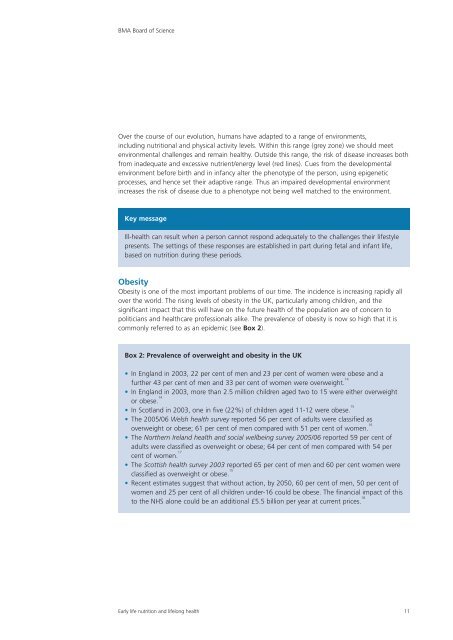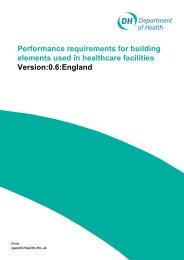BMA Board of ScienceOver the course of our evolution, humans have adapted to a range of environments,including nutritional <strong>and</strong> physical activity levels. Within this range (grey zone) we should meetenvironmental challenges <strong>and</strong> remain healthy. Outside this range, the risk of disease increases bothfrom inadequate <strong>and</strong> excessive nutrient/energy level (red lines). Cues from the developmentalenvironment before birth <strong>and</strong> in infancy alter the phenotype of the person, using epigeneticprocesses, <strong>and</strong> hence set their adaptive range. Thus an impaired developmental environmentincreases the risk of disease due to a phenotype not being well matched to the environment.Key messageIll-health can result when a person cannot respond adequately to the challenges their lifestylepresents. The settings of these responses are established in part during fetal <strong>and</strong> infant life,based on nutrition during these periods.ObesityObesity is one of the most important problems of our time. The incidence is increasing rapidly allover the world. The rising levels of obesity in the UK, particularly among children, <strong>and</strong> thesignificant impact that this will have on the future health of the population are of concern topoliticians <strong>and</strong> healthcare professionals alike. The prevalence of obesity is now so high that it iscommonly referred to as an epidemic (see Box 2).Box 2: Prevalence of overweight <strong>and</strong> obesity in the UK• In Engl<strong>and</strong> in 2003, 22 per cent of men <strong>and</strong> 23 per cent of women were obese <strong>and</strong> afurther 43 per cent of men <strong>and</strong> 33 per cent of women were overweight. 14• In Engl<strong>and</strong> in 2003, more than 2.5 million children aged two to 15 were either overweightor obese. 14• In Scotl<strong>and</strong> in 2003, one in five (22%) of children aged 11-12 were obese. 15• The 2005/06 Welsh health survey reported 56 per cent of adults were classified asoverweight or obese; 61 per cent of men compared with 51 per cent of women. 16• The Northern Irel<strong>and</strong> health <strong>and</strong> social wellbeing survey 2005/06 reported 59 per cent ofadults were classified as overweight or obese; 64 per cent of men compared with 54 percent of women. 17• The Scottish health survey 2003 reported 65 per cent of men <strong>and</strong> 60 per cent women wereclassified as overweight or obese. 15• Recent estimates suggest that without action, by 2050, 60 per cent of men, 50 per cent ofwomen <strong>and</strong> 25 per cent of all children under-16 could be obese. The financial impact of thisto the NHS alone could be an additional £5.5 billion per year at current prices. 18<strong>Early</strong> life nutrition <strong>and</strong> lifelong health 11
BMA Board of ScienceOverweight <strong>and</strong> obesity in developing countriesEconomic development <strong>and</strong> improvements in agricultural production are transforming thenutritional situation for children <strong>and</strong> adults in developing countries, although rising food prices<strong>and</strong> continued food insecurity are a concern. Undernutrition, wasting, stunting <strong>and</strong> micronutrientdeficiencies are still major problems in developing countries, 3 <strong>and</strong> occurring in early life, theycause long-term damage to human capital <strong>and</strong> health. 19 Improved availability of energy-richfoods has however, enabled large numbers of people to escape from hunger. This has broughtconsiderable benefits, but is already giving rise to obesity <strong>and</strong> obesity-related disease. Developingcountries are reporting high rates of coronary heart disease (CHD) <strong>and</strong> type 2 diabetes that haveappeared in one or two generations to become leading causes of morbidity <strong>and</strong> mortality. Theseepidemics are expected to intensify. 20 By the year 2030, the prevalence of diabetes is predicted torise by over 100 per cent in India, China, sub-Saharan Africa, Latin America, the Caribbean <strong>and</strong>the Middle East; an increase far exceeding that in high-income countries (54%). The highestnumber of people with diabetes will be of working age (45-64 years) unlike developed countries,where the greatest numbers are in older age groups, <strong>and</strong> in addition diabetes in pregnancy willbecome a common problem. There are similar increases anticipated in hypertension, CHD <strong>and</strong>stroke. 21 By 2015, an estimated 20 million people will die from cardiovascular disease every year. 21In the context of this report on early life nutrition, obesity is important in a number of ways. Firstly,as described, obesity arising during childhood or adult life, can ‘unmask’ the effects of adaptationsinduced by undernutrition during fetal life or infancy.Secondly, there is good evidence that increased adiposity <strong>and</strong>/or an adverse distribution of body fatis itself an outcome of malnutrition (both undernutrition <strong>and</strong> excessive nutrition) in early life.Adults who had a lower birth weight have been shown to have a higher waist circumference. 22Low birth weight babies born to underweight women in India are excessively adipose relative totheir body weight. 23 In experimental animals, maternal undernutrition during pregnancy isassociated with increased adiposity in the adult offspring. 24 The mechanisms for this phenomenonare unknown, but may arise when the correct balance of nutrients required for tissue synthesis isnot available, leading to energy storage as adipose tissue. 25Maternal obesity, another form of maternal malnutrition, also increases the adiposity of the fetus<strong>and</strong> newborn baby. This phenomenon is exacerbated further if maternal obesity is complicated bygestational diabetes, an example of fetal overnutrition – in which maternal glucose, freely crossingthe placenta, stimulates fetal insulin secretion <strong>and</strong> adipose tissue deposition. It is known thatmaternal gestational diabetes is a risk factor for early-onset type 2 diabetes in the offspring, <strong>and</strong>recent data suggest that maternal obesity alone, even in the absence of gestational diabetes,increase the risks of metabolic syndrome in the offspring. 26 A recent follow-up study of more than9,000 women with normal glucose tolerance at initial screening, found that increasing maternalglycaemia was associated with a greater risk of obesity in the children, even amongst children ofnormal birth weight. Importantly, among those who fulfilled criteria for gestational diabetes, therelationship between maternal glycaemia <strong>and</strong> offspring obesity was lost if the mother receivedtreatment. 27 Maternal obesity is an increasing problem worldwide, <strong>and</strong> it seems likely that this willcontribute increasingly to the burden of diabetes in the future. Gestational diabetes is an exampleof how susceptibility to diabetes can be transmitted non-genetically from one generation to thenext. Women who were themselves of low birth weight are at increased risk of developinggestational diabetes, especially if they become obese in adult life. 2812<strong>Early</strong> life nutrition <strong>and</strong> lifelong health



